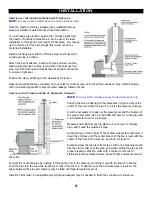
TROUBLESHOOTING GUIDE
18
TROUBLESHOOTING GUIDE
When your stove acts out of the ordinary, the first reaction is to call for help. This guide may save time and money by
enabling you to solve simple problems yourself. Problems encountered are often the result of only five factors: 1) poor
fuel; 2) poor operation or maintenance; 3) poor installation; 4) component failure; 5) factory defect. You can usually
solve those problems related to 1 and 2. Your dealer can solve problems relating to 3, 4 and 5. Refer to diagrams on
page 22 to help locate indicated parts.
For the sake of troubleshooting and using this guide to assist you, you should look at your heat level setting to see which
light is flashing. The Low Heat Level is considered the #1 Light; the one just above the #2 light, the third light is the #3
light, etc., with the High Heat Level being considered the #5 light.
** CAUTION – UNPLUG THE STOVE FROM ALL POWER PRIOR TO ATTEMPTING TO SERVICE THE UNIT! **
Stove Shuts Off and the Second Light Flashes
Possible Causes:
Possible Remedies:
(Unplug stove first)
1.
Airflow switch hose or stove attachment pipes for hose are blocked.
Unhook the red air hose from the air switch and blow through it. If air
flows freely, the hose and tube are fine. If air will not flow throw the
hose, use a wire coat hanger to clear the blockage.
2.
The air inlet, burn pot, interior combustion air chambers, combustion
blower, or exhaust pipe are blocked with ash or foreign material.
Follow all cleaning procedures in the maintenance section of the owner’s
manual.
3.
The firebox is not properly sealed.
Make sure the door is closed and that the gasket is in good shape; replace
if worn. Insure that the ash cleanout doors are fully closed. Ashes will
accumulate under the burn pot; move the damper in and out vigorously to
shake the ashes into the pan, or cool the stove and clean.
4.
Vent pipe is incorrectly installed.
Check to make sure vent pipe installation meets criteria as stated in this
owner’s manual.
5.
The airflow switch wire connections are at fault.
Check the connectors that attach the gray wires to the air switch. Refer to
the wiring diagram in this manual and posted on the stove.
6.
The gray wires are pulled loose at the Molex connector on the wiring
harness.
Check to see if the gray wires are loose at the Molex connector.
7.
Combustion blower failure.
With the stove on with no fire, check to see if the combustion blower is
running. There are cooling vanes visible between the motor and the fan
housing, and you should see them spinning. If the fan is not turning, you
will need to check to see if power is going to the combustion blower with
a multimeter. The blower or control board may need to be replaced;
contact your dealer or Golden Eagle.
8.
Control board is not sending power to combustion blower.
See above.
9.
Air switch has failed (very rare).
To test the air switch, you will need to disconnect the air hose from the
body of the stove. With the other end still attached to the air switch, very
gently suck on the loose end of the hose (you may want to remove the
hose entirely off the stove and the air switch first and make sure it is
clear). If you hear a click, the air switch is working. BE CAREFUL TOO
MUCH VACUUM CAN DAMAGE THE AIR SWITCH.
Otherwise, disconnect the gray wires at the air switch and jump them with
a short piece of wire. If the stove then operates, the air switch may be
bad. NEVER BURN FUEL IN THE STOVE WITH THE AIRSWITCH
JUMPERED.
Summary of Contents for THE LINCOLN
Page 27: ...ELECTRICAL DIAGRAM 23 ...








































